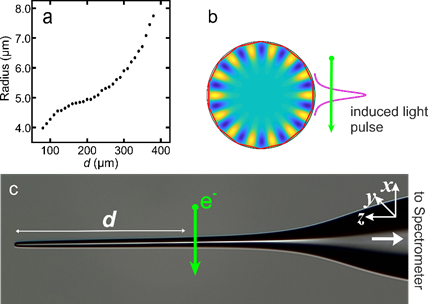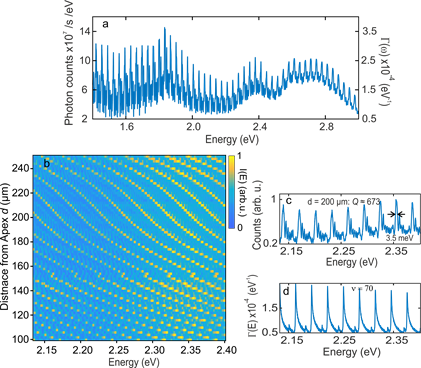Broadband coupling of fast electrons to high-Q whispering gallery mode resonators
- Abstract number
- 1040
- Event
- European Microscopy Congress 2020
- DOI
- 10.22443/rms.emc2020.1040
- Corresponding Email
- [email protected]
- Session
- PST.2 - Microscopy for the study of quantum effects and nano-optics
- Authors
- Niklas Müller (1), Vincent Hock (1), Holger Koch (1), Christopher Rathje (1), Prof. Dr. Sascha Schäfer (1)
- Affiliations
-
1. University of Oldenburg
- Keywords
Broadband
Coherent cathodoluminescence
Frequency combs
Q-factor
Whispering gallery modes
- Abstract text
We demonstrate the electron-induced excitation of optical high-Q whispering gallery modes in silica microfibers in a TEM. Fiber-guided coherent cathodoluminescence (CL) is observed, with CL spectra consisting of an octave-spanning frequency comb with narrow-bandwidth peaks. In agreement with theoretical simulations, the peaks within the comb exhibit a spacing inversely scaling with the fiber circumference, reaching cavity Q-factors above 650.
The inelastic interaction of fast electrons with spatially confined intense light fields has recently enabled new techniques in ultrafast transmission electron microscopy (UTEM) [1,2], including the coherent control of free-electron states [3]. Whereas previous work focused on coherent light states as driving fields, advanced quantum control scenarios, including electron-light entanglement and non- trivial electron/photon counting statistics, become accessible if non-classical (quantum optical) light states are applied [4-6]. Historically, progress in quantum optics heavily relied on the development of high-quality (high-Q) optical cavities [7], suggesting that the investigation of approaches to couple a TEM electron beam to such cavities may enable novel forms of quantum electron microscopy.
In our experiments, we pass a focused electron beam (200 keV electron energy, about 10 nm electron focal spot size) close to the surface of a tapered silica fiber. The evanescent electric field of the passing electron induces a transient electric polarization in the silica resulting in a spatially and temporally confined light pulse that is guided by total internal reflection around the fiber circumference and spreading along the fibre axis (Fig 1 b). The induced light pulse can be described as a coherent superposition of the resonator eigenmodes, called whispering gallery modes (WGM). Using a home-built TEM sample holder, the fibre is guide outside of the TEM and connected to a sensitive, high-resolution optical spectrometer (Fig. 1 a,c).
Figure 1. Experimental principle. a Fiber radius dependence on the fiber apex distance. b Electron induces ultrashort light pulse by passing the fiber surface. c Microscopic image of the used fiber taper.
The observed coherent cathodoluminescence spectra exhibit an octave-spanning frequency combs with narrow-bandwidth peaks (Fig. 2 a), indicating multiple beam interference within the resonator and pointing towards a long mode lifetime. The comb spacing can directly be related to the roundtrip time of the induced light pulse in the fiber geometry. Considering the detected photon count rate and the electron beam current, an overall electron-photon conversion efficiency of 0.02% is reached. By probing the WGM resonances for different distances from the taper apex, we demonstrate that the resonance frequencies and the spacing of the comb scale inversely with the local diameter of the fibre (Fig. 2 b).
Figure 2. Coherent cathodoluminescence. a Experimental comb-like cathodoluminescence spectrum with octave spanning spectral width in the visible range. G: in- elastic scattering efficiency. b Observed CL-spectra depending on the electron excitation position d measured from the tip apex. I(E): normalized spectra intensity. c Line-out of CL-map shown in b, exhibiting the highest measured Q-factor of 673. d Simulation of the spectral electron energy loss probability for a dielectric silica cylinder, demonstrating the broadband excitation of whispering gallery modes.
CL spectra with peak widths down to about 3.5 meV are observed (Fig. 2 c), when the electron focus is placed at a section of the fibre tip which is approximately cylindrical (at a distance of about 200 µm from the tip apex). The corresponding quality factor of the open cavity is extracted to be about 670. The experimental results are further compared to simulations of the electron energy loss probability using a transition matrix method [8]. Both experiment and simulation are in a qualitatively good agreement, both regarding the overall spectral shape but also with respect to the absolute EEL probability (Fig. 2 d).
In conclusion, we have demonstrated the broadband coupling of fast electrons to whispering gallery type resonator modes. The high Q-factor of above 650 corresponds to a mode lifetime of a few picoseconds, resulting in a phase-stable memory of the arrival time of a single electron with sub-femtosecond resolution. Further improvements of the resonator quality are expected for drop-shaped silica beads and will further increase the mode lifetimes, possibly allowing for an entanglement between different electrons within a beam. Further work will focus on the photon counting statistics of the coherent cathodoluminescence light.
- References
[1] B. Barwick et al., Nature 462 (2009) p. 902–906.
[2] F. G. de Abajo and M. Kociak, New J. Phys. 10 (2008) p. 073035.
[3] A. Feist et al., Nature, 521 (2015) p. 200–203.
[4] S. Meuret et al., Phys. Rev. Lett. 114 (2015) p. 197401.
[5] O. Kfir, Phys. Rev. Lett. 123 (2019) p. 103602.
[6] J. Hyun et al., Appl. Phys. Lett. 93 (2008) p. 243106.
[7] H. Walther et al., Rep. Prog. Phys., 69 (2006) p. 1325.
[8] S. V. Yalunin et al., Phys. Rev. B, 93 (2016) p. 115408.


